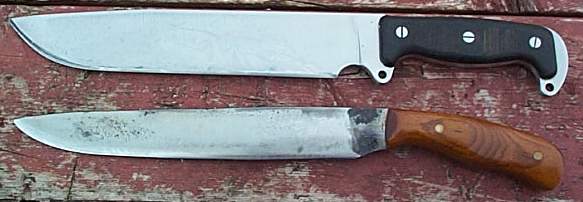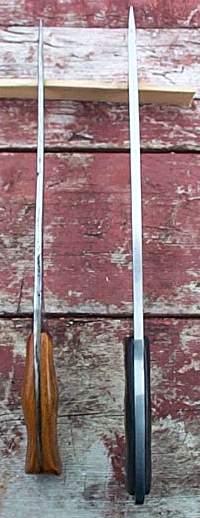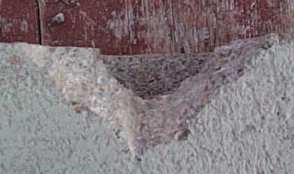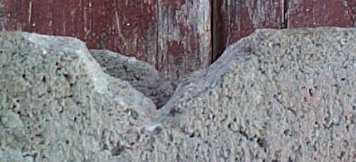
A couple of shots of Ray's bowie alongside the Battle Mistress from Busse Combat :

and a top down shot :

This bowie was forged from 52100 and is a quarter of an inch thick across at the spine and about 1.4" at the widest with a slight distal taper. The bowie weighs 400 g with a balance point 5.0 centimeters in front of the middle of the index finger in a hammer grip. Both the primary and secondary grinds are convex down. The edge is very thin, with a wide bevel, the curvature is very light, close to an 11 degree flat bevel for most of its extent.
Ray's bowie would shave arm hair with a light push and could free shave coarse hair. It would push cut through photocopy paper, free-hanging or folded upright in a vee. It would also slice into the top and sides of a free-hanging 12 inch length of paper-towel producing 3-4 inch cuts. To quantify its sharpness as well as to allow an edge retention judgment, stock cutting on thread and quarter inch poly was performed with the bowie, and the Battle Mistress from Busse Combat for a reference.
Ray had buffed the edge with green chrome rouge from Texas Knifemakers Supply. The edge on the Battle Mistress was obtained by using an x-coarse DMT benchstone, then a fine one and finally using a piece of 1000 grit SiC sandpaper on 1/4" soft leather to put a hint of a convex edge on the blade as well as increase the polish a little. In short, both knives performed at an equal level in push cutting the light thread and slicing through 1/4" poly under light loads.
| Model | Thread | cm of edge required to slice through 1/4" poly | |||
|---|---|---|---|---|---|
| grams | 200 g | 500 g | 700 g | 1000 g | |
| JS Bowie | 145 (5) | 64 (21) | 2.13 (16) | 1.50 (11) | 0.75 (11) |
| Battle Mistress | 133 (9) | 64 (11) | 2.00 (16) | 1.25 (9) | 0.75 (8) |
There is as expected a general decrease in the edge length required as the force on the cord is increased. A greater amount of tension in the cord will produce a directly greater pressure on the cord by the edge of the knife and thus allow the micro-serrations to cut deeper with less travel along the cord.
Update : Note somewhere between 500 g and 200 g both blades lose their slicing ability almost completely. At this point the load may not be high enough to produce sufficient tension in the cord so as to allow it to be penetrated by the edge and thus it will flow around the edge instead of being cut. It might be interesting to look at how this "cutoff" point is effected by various grit finishes and if it is different for either blade.
Comparing the performance on thick and binding material, the blades were used to sliced up varies pieces of wood. Cut lengths of 1.5, 2 and 3 inches were used, with the wood ranging from soft pine to seasoned hardwoods. The wood ranged in size from 0.5 to 2" thick and from 1.5 to 3 inches wide. Two trials were ran, the first had frequent rests, with breaks after every five cuts for 30 seconds, as well as resting for three minutes between working with each blade. Another trial was done with no breaks to show the effect of fatigue. The wood on average required about 20 slices per stick with the Battle Mistress. In short, the cutting ability of Ray Kirk's bowie was significantly greater and this difference was enhanced with fatigue. Some details
| Model | Rank | |||
|---|---|---|---|---|
| Rested | Fatigue | |||
| Spread | Median | Spread | Median | |
| JSB | 100 | |||
| BM | 40 - 62 | 51 (4) | 29 - 45 | 36 (3) |
Based on the edge angles alone, Battle Mistress should be about 70, the performance is lowered further as the edge on Ray's bowie starts closer to the handle so there is less of a torque disadvantage, as well it has an the dropped blade. Both of these influences were factored out by examining cutting performance through rope.
Some used 1/2" poly was push cut using a rocking motion with both knives. This rope was full of dirt, the cutting block had to be brushed off after after every cut to prevent the blades from cutting gravel. As expected the results were more inline with the edge angle ratio :
| Model | During the cutting | After the cutting |
|---|---|---|
| Force (lbs) | Force (lbs) | |
| JSB | 67 (2) | 77 (2) |
| BM | 98 (1) | 97 (1) |
The Battle Mistress showed no further significant degradation, whereas the forged bowie had degraded slightly. However the forged bowie was still significantly out cutting the Battle Mistress on the poly because of its higher performance geometry. Some 3/8" cord was cut in a similar manner as a check, 64 +/- 3 lbs for Ray's Bowie, and 84 +/- 3 for the Battle Mistress. A drop of about 15-20 % .
Both blades were restored to shaving sharp with a few strokes on a canvas strop followed by a few passes on the leather side loaded with CrO. They had however lost some bite on the 1/4" poly, mainly due to the polished nature of the CrO buffing compound, which is about 10 000 grit. To restore the initial high level of aggression, stop on five micron SiC sandpaper or similar.
During the limbing, Ray's bowie held up well even on the hardest work. Even at the extreme end of cutting into the most seasoned branches, the edge only took light damage. After a half dozen of such trees cleared there were a couple of dents from 0.5 to one millimeter in depth and from one to two millimeters in length. These dents were repaired using a small hammer to work the edge back in line and then a steel to finish it off.
As a check of performance for accidental high stress impacts, the bowie was used to hack into a concrete block. First off 100 light chops were performed, swinging from the elbow. These chops removed quite a bit of the block :

The blade was not significantly damaged, just dulled :

There was no extensive fracture. The occasional rock impacts left a flat surface of steel about 0.015" thick and about twice as long which would take some time to grind out. More chopping was performed on the other side of the block. Heavier swings which made a similar sized notch in only fifty chops :

The chopping was concentrated in one spot to allow a comparison to the elbow chopping. The difference was not significant enough to pick up on camera but could be seen by eye. The knife was damaged to a greater extent now leaving an "edge" about 0.03" thick in the heavy contact areas. The points of rock impacts are clearly evident as abrupt patches of damage about 0.035" or so across. There was still no evidence of extensive fracture.
For reference 25 light chops were performed with the WB from Strider on the same block. These chops basically only blunted the edge, which suffered chipping but the damage was only about 0.005" to 0.01" deep. However chopping from the shoulder induced large fractures. After another 25 chops the entire bevel was lost in several places which was damage about 0.035" in depth. The blade also suffered fractures of the primary grind :

The large notch is about 0.140" deep and 0.425" long. There are a couple of smaller notches where the fractures are about about 0.05" deep and 0.10" long. The WB has a much thicker and more obtuse edge than Ray's bowie and is also not as powerful a chopper yet takes far more damage. This difference is due to the inherent very brittle nature of ATS-34 compared to a much tougher and more ductile 52100.
Comments can be sent to : cliffstamp[REMOVE]@cutleryscience.com or by posting in the following thread :
ABS has the performance test for a Journeyman Smith rating online. More information can be seen about Ray's knives on the Raker Knives website.
| Last updated : | Thu May 29 17:43:34 NDT 2003 |
| Mon Jul 2 12:36:54 NDT 2001 |